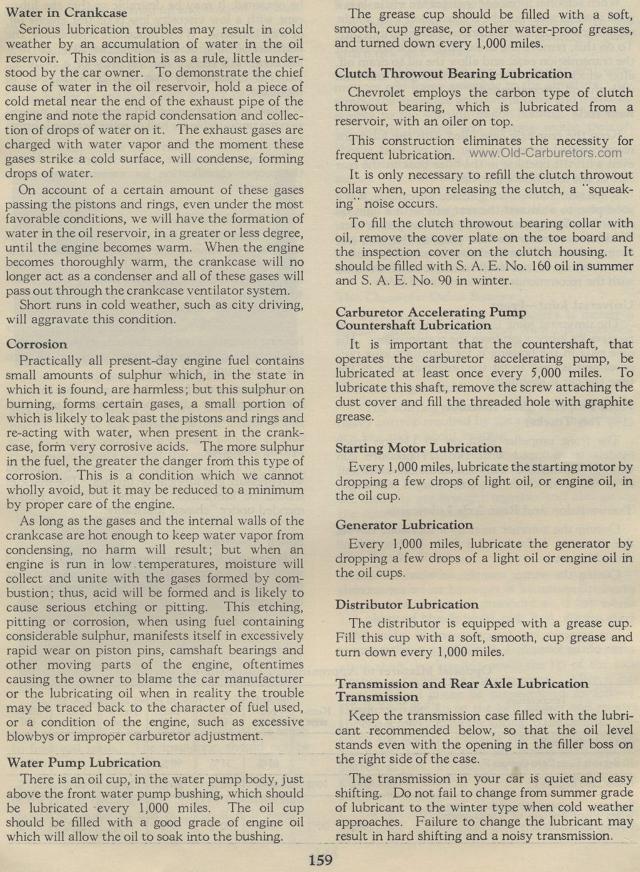1935 Chevy Water in Crankcase
Serious lubrication troubles may result in cold weather by an accumulation
of water in the oil reservoir. This condition is as a rule, little
under-stood by the car owner. To demonstrate the chief cause
of water in the oil reservoir, hold a piece of cold metal near
the end of the exhaust pipe of the engine and note the rapid
condensation and collection of drops of water on it.
The exhaust
gases are charged with water vapor and the moment these gases
strike a cold surface, will condense, forming drops of water.
On account of a certain amount of these gases passing the pistons
and rings, even under the most favorable conditions, we will
have the formation of water in the oil reservoir, in a greater
or less degree, until the engine becomes warm. When the engine
becomes thoroughly warm, the crankcase will no longer act as
a condenser and all of these gases will pass out through the
crankcase ventilator system.
Short runs in cold weather, such as city driving, will aggravate
this condition.
Corrosion
Practically all present-day engine fuel contains small amounts
of sulphur which, in the state in which it is found, are harmless;
but this sulphur on burning, forms certain gases, a small portion
of which is likely to leak past the pistons and rings and re-acting
with water, when present in the crank-case, form very corrosive
acids. The more sulphur in the fuel, the greater the danger from
this type of corrosion. This is a condition which we cannot wholly
avoid, but it may be reduced to a minimum by proper care of the
engine.
As long as the gases and the internal walls of the crankcase
are hot enough to keep water vapor from condensing, no harm will
result; but when an engine is run in low temperatures, moisture
will collect and unite with the gases formed by combustion; thus,
acid will be formed and is likely to cause serious etching or
pitting. This etching, pitting or corrosion, when using fuel
containing considerable sulphur, manifests itself in excessively
rapid wear on piston pins, camshaft bearings and other moving
parts of the engine, oftentimes causing the owner to blame the
car manufacturer or the lubricating oil when in reality the trouble
may be traced back to the character of fuel used, or a condition
of the engine, such as excessive blowbys or improper carburetor
adjustment.
Water Pump Lubrication
There is an oil cup, in the water pump body, just above the front
water pump bushing, which should be lubricated every 1,000 miles.
The oil cup should be filled with a good grade of engine oil
which will allow the oil to soak into the bushing.
159
The grease cup should be filled with a soft, smooth, cup grease,
or other water-proof greases, and turned down every 1,000 miles.
Clutch Throwout Bearing Lubrication
Chevrolet employs the carbon type of clutch throwout bearing, which
is lubricated from a reservoir, with an oiler on top.
This construction eliminates the necessity for frequent lubrication.
It is only necessary to refill the clutch throwout collar when,
upon releasing the clutch, a "squeaking" noise occurs.
To fill the clutch throwout bearing collar with oil, remove the
cover plate on the toe board and the inspection cover on the clutch
housing. It should be filled with S. A. E. No. 160 oil in summer
and S. A. E. No. 90 in winter.
Carburetor Accelerating Pump Countershaft Lubrication
It is important that the countershaft, that operates the carburetor
accelerating pump, be lubricated at least once every 5,000 miles.
To lubricate this shaft, remove the screw attaching the dust cover
and fill the threaded hole with graphite grease.
Starting Motor Lubrication
Every 1,000 miles, lubricate the starting motor by dropping a few
drops of light oil, or engine oil, in the oil cup.
Generator Lubrication
Every 1,000 miles, lubricate the generator by dropping a few drops
of a light oil or engine oil in the oil cups.
Distributor Lubrication
The distributor is equipped with a grease cup. Fill this cup with
a soft, smooth, cup grease and turn down every 1,000 miles.
Transmission and Rear Axle Lubrication Transmission
Keep the transmission case filled with the lubricant recommended
below, so that the oil level stands even with the opening in the
filler boss on the right side of the case.
The transmission in your car is quiet and easy shifting. Do not
fail to change from summer grade of lubricant to the winter type
when cold weather approaches. Failure to change the lubricant may
result in hard shifting and a noisy transmission.

|
